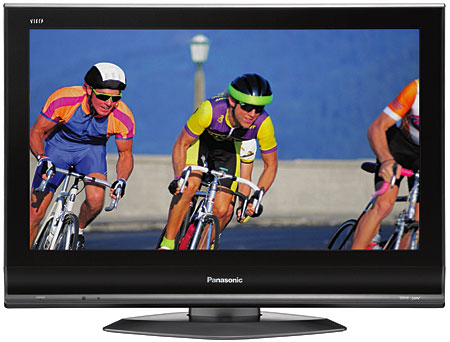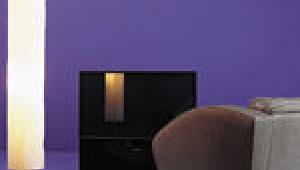Are You Getting All of the HDTV Resolution You Expected? Round 3
This time last year, we tested 61 2006 HDTVs to learn how they process all the detail contained within 1080i, the most common high-definition broadcast format. It's the highest resolution format the majority of HD broadcasters and cable channels use, including CBS, NBC, CW, HBO, and Showtime. The results of our 2006 tests were quite disappointing; less than half of the HDTVs were able to properly process the interlaced broadcast signal to the TV's native, progressive resolution. This year, we have expanded our testing to include 74 HDTVs that range from 19 to 67 inches. We have added a new test for 1080p displays to judge their resolution with motion as compared to their stationary resolution. This test illustrates how all HDTVs lower the amount of detail you can see when the camera is panning or where there is action in a scene, such as on a football field. More on this later.

What Goes Into a Great HD Picture?
The most important thing to remember as you read this article is that there are many factors involved in developing a great HD picture. These tests—along with a set's ability to produce black, the actual contrast ratio (the ratio of black to white), the color accuracy, and more—all play a part. The tests performed here are important, but they only represent aspects of each TV's overall performance. You should not judge a TV based solely on these tests (or any single aspect of performance).
I tested all 74 HDTVs for two important criteria. I measured each display's ability to deinterlace 1080i signals and also sought to learn whether these displays could convert film-based content (24 frames per second) to the HDTVs' display rates without losing detail. (Usually this was 60 hertz, many new120-Hz sets arrived too late to be included in this roundup.) The results can help guide you as you purchase an HDTV, but I must emphasize that not all of the passing sets looked great and not all of the non-passing ones appeared bad. However, that being said, an HDTV that fails to deinterlace a 1080i signal (broadcast and a few HD DVD and Blu-ray discs) will cut the signal's resolution up to 50 percent (540 horizontal lines). This is very noticeable when comparing HDTVs, especially if they're all 1080p displays. More on this below.
Deinterlacing
Using the latest Silicon Optix HQV Benchmark Blu-ray test disc, I displayed a 1080i SMPTE 133 pattern from a Panasonic DMP-BD10 Blu-ray player. In the corners and to the right of the middle of the image are boxes with alternating, horizontal black and white lines a single pixel high. The player sends the TV the white lines (odd numbered) in the first field, and the second field contains the black lines (even numbered). The TV then has to combine these two fields into one frame to display on the screen. Done correctly, you'll see white and black alternating lines. Done incorrectly, you'll see a flashing box that flashes between solid black and solid white. This indicates that the display is only showing one 540-line field at a time and upconverting it to the display's native resolution (say, 1080p). If this occurs at any time, I give the display a "Fail" because it only works with half of the available information as it strobes. The deinterlacing test pattern also adds a motion component in the form of a clockwise rotating white line positioned on the left side of the image. Proper deinterlacing of still frames doesn't matter in this case, as we are dealing with "motion" pictures, not a slide show.

3:2 Tests
Most scripted television shows and almost all movies are filmed at 24 frames per second. Film is still the predominant medium for both film and TV, but that is slowly changing to HD video (which is also almost always 24 fps for this type of programming).
For television broadcast, the 24 fps are converted to 30 fps (or, more accurately, 60 fields per second) using a process called telecine. The first film frame is split into two fields, the second film frame is split into three fields, and so on. This is where the 3:2 (more accurately, 2:3) sequence comes from; every other film frame has an additional field for a 2:3 cadence. For more information on this, check the GearWorks in the June 2007 issue also here.
The problem arises when a TV tries to re-combine (deinterlace) the 1080i fields into 1080p frames. Done incorrectly, you can have artifacts when the processor combines parts of different fields into mismatched frames.
A good processor should recognize when there is a 3:2 sequence in the video signal and only combine like fields (say, the first two fields that are from just the first film frame). This process is called inverse telecine. Done right, you'll see everything from the original film frame. That's worth repeating. As far as film-based content is concerned, as long as the 1080i is deinterlaced properly, it will appear identical to the original 1080p content. Done incorrectly, you can have artifacts, or worse, a loss of resolution when anything on the screen moves.
The 3:2 test also uses the SMPTE 133 pattern, minus the white line and with the pattern moving back and forth across the screen at 24 fps. The Silicon Optix HQV Blu-ray disc is mastered at 1080i/30 with a 3:2 cadence inserted, like any 24-frame film transfer to video. If the processor properly handles the signal, the boxes with the horizontal lines described above will remain intact. If not, either the boxes will strobe between all black and all white (as with the deinterlace test), or you will see vertical bands on the sides of the box. Strobing or banding constitutes a "fail," as resolution will drop during pans.
Bandwidth Test
I used a Sencore Model 403 signal generator to create the test signal. I set the generator's output to 1080i and examined the portion of the pattern where a series of black and white lines appear. The alternating vertical lines are each exactly one pixel wide. A display rated "full bandwidth" should show each line as either black or white (or nearly black or light gray) to qualify as full bandwidth. (There are some other factors that may cause the set to not display the image as deep black and 100-percent full white, which is why we allow some leeway.) To qualify as "some" bandwidth in the accompanying chart, the image drops some of the lines or the lines are clearly mid-gray to dark-gray instead of black or white. "None" is just as the name implies: a blank gray area with no visible structure. Some of the sets I tested displayed the lines bunched up as groups because these displays did not have a pixel-for-pixel of 1:1 aspect ratio. This phenomenon is known as aliasing. These sets expand the image and draw fewer lines across the screen (about 1,820 from left to right, rather than 1,920). I did not take the aliasing into account for each display's grade, and I used the above criteria to determine if the display passes "full" or "some" bandwidth. Fortunately, overall, the sets did much better than the 2006 models, with no set earning a "None" rating this year. All the HDTVs that I tested for bandwidth are 1080p.

Static and Motion Resolution
A new test for this year takes a step further beyond the bandwidth test and judges how well a display is able to handle moving resolution. Because much of what we all watch has motion in it, this test is a valuable tool in judging what we'll really see when watching program material like sports and action movies or with gaming. A consumer electronics industry association created the FPD Benchmark Software for the Professional Blu-ray disc to "accurately evaluate the performance parameters" of displays. The test pattern I selected for our tests is called a monoscope pattern, which consists of a series of four black lines drawn so that they gradually become closer together to form a wedge pattern. You can see this series of wedges at the bottom, top, and sides of a center circle. To test horizontal motion resolution, you look at the bottom wedges. The first pattern is stationary, and the number listed is determined by how close the lines can be displayed and still be discerned as four separate lines. The numbers adjacent to the lines indicate the disc's resolution at those coordinates. The highest number—seen at the point where the four lines begin to merge or blur—is recorded as the static number.
The same pattern is also displayed moving from left to right. The software notes the point at which the pattern blurs and you can no longer distinguish the four lines. This test is somewhat subjective. For instance, I asked some of the store salespeople at the location where I conducted these tests to provide their observations. The numbers varied slightly from observer to observer, but it was always within 25 points of the number I selected. For the sake of consistency, I picked all of the numbers that are recorded in the chart. All the HDTVs I tested for stationary and motion performance were 1080p models.
Analysis and Clarifications
Overall, this year's HDTVs have significantly improved deinterlacing abilities, with a 64.86-percent pass rate, up from last year's 45.91 pass rate. The failure rate for proper 3:2 processing is still very poor at 81.09 percent. However, there is a partial workaround for displays that can accept native 1080/60p signals. The Onkyo DV-HD805 and Toshiba HD-XA2 HD DVD players will deinterlace 1080i and properly handle the 3:2 cadence if you set them for 1080/60p output because of their built-in Silicon Optix HQV processor. In the Blu-ray camp, the new Samsung BD-P2400 and BD-UP5000 Blu-ray/HD DVD combo player have the same signal processor. Panasonic's DMP-BD10A is one of the few players that doesn't use the HQV chip but still deinterlaces and picks up the 3:2 sequence correctly.
Of course, none of these will help broadcast, cable, or satellite 1080i HD sources, and they will really only help if you like 1080i HD concert discs, as all movie-based discs are 1080p/24 natively. To date, the various set-top boxes for cable and satellite will only output up to 1080i.The 1080p displays' static and motion tests should be of great interest to anyone who watches sports and action movies. With the lower-rated displays, for example, the pinstripes on the New York Yankees' home uniform disappear as the pitcher moves on the mound, and numbers on the sides of the NASCAR racers become a blur as they whiz by the camera. The displays' performance went hand in hand with the technology. Flat-panel LCD had the lowest performance when it came to motion detail, with a range of 360 (an exceptionally low score) to 600. The rear projectors using LCOS (Liquid Crystal on Silicon) or DLP (Digital Light Processing technology) were the next best in performance, with motion scores ranging from 650 to 700 lines. The plasma sets produced the best motion detail, with a range of 830 to 880 lines.
There were a few odd behaviors that required special settings for specific displays. I had to manually adjust the larger-screen Sharp LCD flat panels that earned the pass on deinterlacing into Film mode. For this, I had to use the remote control that came with the display because there is no access available via a Menu button on any Sharp HDTV. I also had to adjust the Pioneer set to Advanced mode to enable its 72-Hz scan rate, which allowed the 2007 model to pass the 3:2 test. It failed in the factory default 60-Hz mode. JVC's rear projectors and some Sharp LCDs would produce a Pass or Fail (as noted), depending on whether the test signal was delivered via HDMI or component video. In these cases, I counted it as a failure in the final tally.
Click on chart for larger version.
- Log in or register to post comments




























































